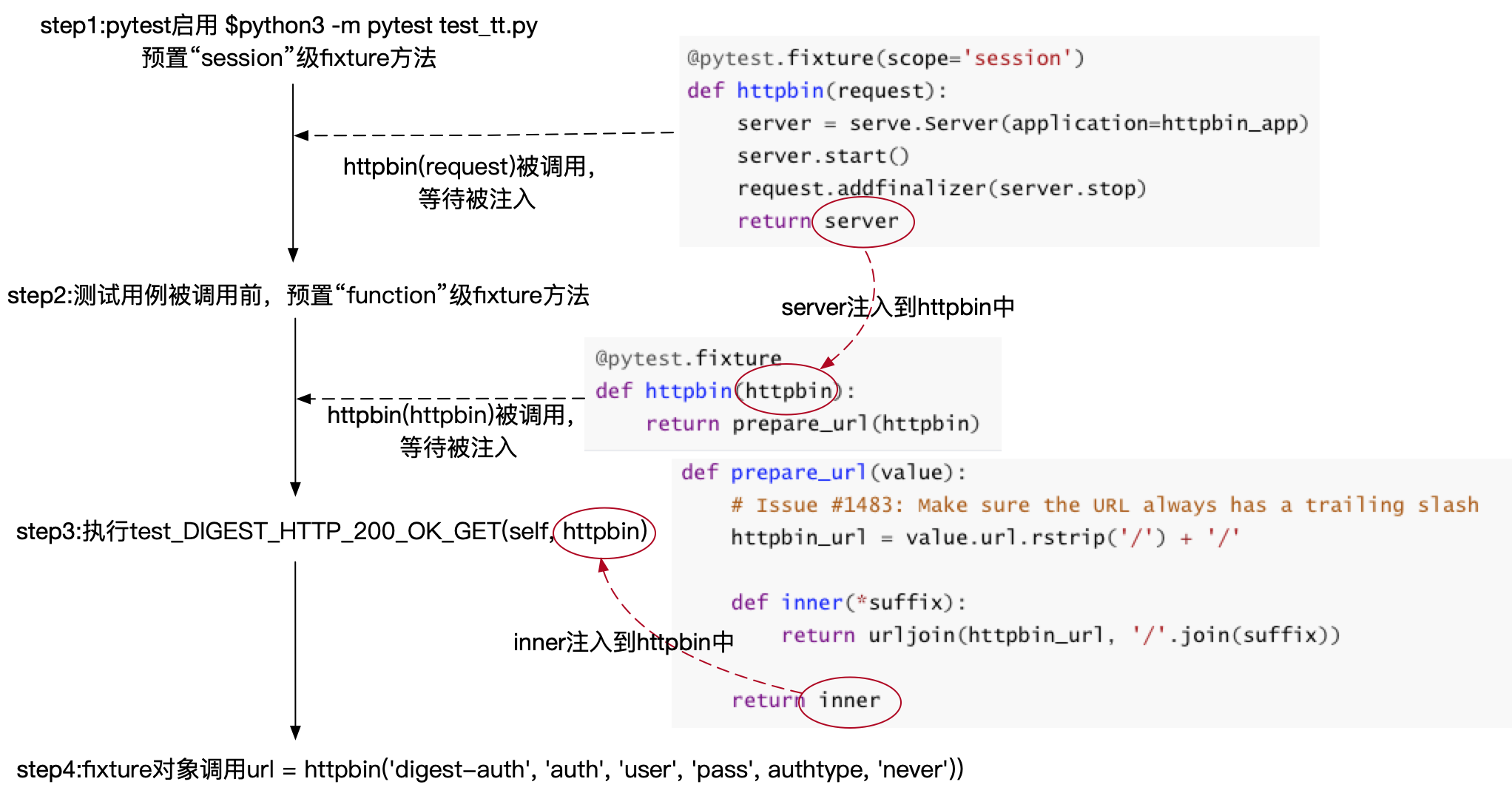# Requests 源码阅读-Day1
[toc]
# Requests介绍
requests是一个Python的网络请求库,和urllib、httplib之流相比起来最大的优点就是好用,requests官方标榜的就是“我们的库是给人用的哦”。
此外,requests还支持https验证并且是线程安全的
# 分析环境
Requests版本: V2.20.0
python版本: 3.6.7
# 源码分析
首先git clone源码到本地,然后使用cloc工具查看文件格式
如果系统没有cloc工具,可以进行安装。 由于我本地是fedora系统,可以使用dnf install cloc命令进行安装
使用下面命令查看项目关于python文件的统计情况:
[jian@laptop requests]$ cloc --include-lang=Python .
| Language | files | blank | comment | code |
|---|---|---|---|---|
| Python | 35 | 1951 | 1990 | 5937 |
可以看到总共python文件有35个,代码量是5937行
# 单元测试
[jian@laptop requests]$ pwd
/home/jian/prj/github/requests
[jian@laptop requests]$ python
Python 3.6.7 (default, Mar 21 2019, 20:23:57)
[GCC 8.3.1 20190223 (Red Hat 8.3.1-2)] on linux
Type "help", "copyright", "credits" or "license" for more information.
>>> import requests
>>> r = requests.get("http://www.baidu.com")
>>> r.status_code
200
打开README.md文件看看requests当前都支持哪些功能
International Domains and URLs #国际化域名和URLS
Keep-Alive & Connection Pooling #keep—Alive&连接池
Sessions with Cookie Persistence #持久性cookie的会话
Browser-style SSL Verification #浏览器式SSL认证
Basic & Digest Authentication #基本/摘要认证
Familiar dict–like Cookies #key/value cookies
Automatic Decompression of Content #自动内容解压缩
Automatic Content Decoding #自动内容解码
Automatic Connection Pooling #自动连接池
Unicode Response Bodies #Unicode响应体
Multi-part File Uploads #文件分块上传
SOCKS Proxy Support #HTTP(S)代理支持
Connection Timeouts #连接超时
Streaming Downloads #数据流下载
Automatic honoring of .netrc #netrc支持
Chunked HTTP Requests #Chunked请求
看源码看的是思想,要明白作者的设计思路到底是什么。
比如requests,看完了你应当问问自己,cookie为什么要封装而不是直接用?request为什么要有两个形态?设计session是为了解决什么问题?
只有理解了设计思路,再去看具体的细节实现才能有收获,否则你看到的就是满屏的raise、isinstanceof,这样去看代码恐怕是浪费时间了。
so...开始开干吧
# test_requests.py
源码目录下有一个tests文件夹,这里面以test开头的测试文件是专门用于测试requests接口,使用的是pytest方式,pytest我会单独写一章节介绍具体的内容
首先选第一个方法分析,找到test_DIGEST_HTTP_200_OK_GET方法
tests/test_requests.py
def test_DIGEST_HTTP_200_OK_GET(self, httpbin):
for authtype in self.digest_auth_algo:
auth = HTTPDigestAuth('user', 'pass')
url = httpbin('digest-auth', 'auth', 'user', 'pass', authtype, 'never')
r = requests.get(url, auth=auth)
assert r.status_code == 200
r = requests.get(url)
assert r.status_code == 401
print(r.headers['WWW-Authenticate'])
s = requests.session()
s.auth = HTTPDigestAuth('user', 'pass')
r = s.get(url)
assert r.status_code == 200
上面这段代码主要做了下面的工作:
1.传递一个httpbin参数,这个
httpbin是什么东西?
2.遍历不同的摘要认证算法,
self.digest_auth_algo是什么?
3.摘要认证变量auth及url变量设置,
HTTPDigestAuth是什么?
4.对url发起get请求,200表示请求成功,401表示未经授权。
这个测试是为了验证auth的必要性
5.新建了一个会话对象s,同时也设置了auth变量,跟前面不同的是这个请求是由会话对象s发起的
# digest_auth_algo
首先回答前面说的self.digest_auto_algo的问题:
tests/test_requests.py
class TestRequests:
digest_auth_algo = ('MD5', 'SHA-256', 'SHA-512')
....
摘要访问认证,它是一种协议规定的web服务器用来同网页浏览器进行认证信息协商的方法。
浏览器在向服务器发送请求的过程中需要传递认证信息auth
auth经过摘要算法加密形成秘文,最后发送给服务器。
服务器验证成功后返回“200”告知浏览器可以继续访问
若验证失败则返回"401"告诉浏览器禁止访问。
当前该摘要算法分别选用了"MD5","SHA-256","SHA-512"。
# HTTPDigestAuth
tests/test_requests.py
from requests.auth import HTTPDigestAuth, _basic_auth_str
看到是导入requests.auth模块里面的HTTPDigestAuth方法 好 我们去查看下这个东西是什么?
requests/auth.py
class HTTPDigestAuth(AuthBase):
"""Attaches HTTP Digest Authentication to the given Request object."""
def __init__(self, username, password):
self.username = username
self.password = password
# Keep state in per-thread local storage
self._thread_local = threading.local()
....
def __call__(self, r):
# Initialize per-thread state, if needed
self.init_per_thread_state()
# If we have a saved nonce, skip the 401
if self._thread_local.last_nonce:
r.headers['Authorization'] = self.build_digest_header(r.method, r.url)
try:
self._thread_local.pos = r.body.tell()
except AttributeError:
# In the case of HTTPDigestAuth being reused and the body of
# the previous request was a file-like object, pos has the
# file position of the previous body. Ensure it's set to
# None.
self._thread_local.pos = None
r.register_hook('response', self.handle_401)
r.register_hook('response', self.handle_redirect)
self._thread_local.num_401_calls = 1
return r
...
HTTPDigestAuth:为http请求对象提供摘要认证。
实例化对象auth时需要传入认证所需的username及password。
threading.local()在这里的作用是保存一个全局变量,但是这个全局变量只能在当前线程才能访问,每一个线程都有单独的内存空间来保存这个变量,它们在逻辑上是隔离的,其他线程都无法访问。
我们可以通过实例演示一下摘要认证:
[jian@laptop requests]$ python
Python 3.6.7 (default, Mar 21 2019, 20:23:57)
[GCC 8.3.1 20190223 (Red Hat 8.3.1-2)] on linux
Type "help", "copyright", "credits" or "license" for more information.
>>> import requests
>>> from requests.auth import HTTPDigestAuth
>>> r = requests.get('http://httpbin.org/digest-auth/auth/user/pass',auth=HTTPDigestAuth
... ('user','pass'))
>>> r.status_code
200
# httpbin
终于要解决这个东西了,这个东西是啥呢?
1.设置断点: tests/conftest.py
@pytest.fixture
def httpbin(httpbin):
pytest.set_trace() # 设置断点
return prepare_url(httpbin)
在tests目录新创建个文件test_xx.py tests/test_xx.py
from requests.auth import HTTPDigestAuth
import requests
import pytest
class TestRequests:
digest_auth_algo = ('MD5', 'SHA-256', 'SHA-512')
def test_DIGEST_HTTP_200_OK_GET(self, httpbin):
for authtype in self.digest_auth_algo:
auth = HTTPDigestAuth('user', 'pass')
url = httpbin('digest-auth', 'auth', 'user', 'pass', authtype,
'never')
pytest.set_trace() # 设置断点
r = requests.get(url, auth=auth)
assert r.status_code == 200
r = requests.get(url)
assert r.status_code == 401
print(r.headers['WWW-Authenticate'])
s = requests.session()
s.auth = HTTPDigestAuth('user', 'pass')
r = s.get(url)
assert r.status_code == 200
然后在终端执行
[jian@laptop requests]$ pwd
/home/jian/prj/github/requests
[jian@laptop requests]$ pytest tests/test_xx.py
xxx
@pytest.fixture
def httpbin(httpbin):
E fixture 'httpbin' not found
怎么报错呢? -说httpbin 这个fixture没有找到
查资料是说缺少pytest-httpbin模块
pip安装起来:
pip install pytest-httpbin
然后再次执行 pytest tests/test_xx.py命令
[jian@laptop requests]$ pytest tests/test_xx.py
Test session starts (platform: linux, Python 3.6.7, pytest 3.2.1, pytest-sugar 0.9.2)
rootdir: /home/jian/prj/github/requests, inifile: pytest.ini
plugins: sugar-0.9.2, pep8-1.0.6, mock-1.6.2, httpbin-1.0.0, flakes-2.0.0, env-0.6.2, cov-2.5.1, assume-2.2.0, allure-adaptor-1.7.10, celery-4.4.0
>>>>>>>>>>>>>>>>>>>>>>>>>>>>>>>>>>>>>>>>>>>>>>>>>>>>>>>>>> PDB set_trace (IO-capturing turned off) >>>>>>>>>>>>>>>>>>>>>>>>>>>>>>>>>>>>>>>>>>>>>>>>>>>>>>>>>>>
> /home/jian/prj/github/requests/tests/conftest.py(20)httpbin()
-> return prepare_url(httpbin)
(Pdb) httpbin
<pytest_httpbin.serve.Server object at 0x7f5e78e44438>
(Pdb) c
>>>>>>>>>>>>>>>>>>> PDB set_trace (IO-capturing turned off) >>>>>>>>>>>>>>>>>>>>
> /home/jian/prj/github/requests/tests/test_xx.py(18)test_DIGEST_HTTP_200_OK_GET()
-> r = requests.get(url, auth=auth)
(Pdb) httpbin
<function prepare_url.<locals>.inner at 0x7f5e78ea3c80>
(Pdb) url
'http://127.0.0.1:44131/digest-auth/auth/user/pass/MD5/never'
(Pdb)
在调试窗口PDB set_trace中可以看到,首先被调用的是的conftest.py中的httpbin()方法
我们在(pdb)中输入httpbin变量,结果 返回了<pytest_httpbin.serve.Server object at 0x7f5e78e44438>
然后继续调用方法test_DIGEST_HTTP_200_OK_GET(),输入httpbin变量,结果返回了<function prepare_url.
经过调试后,httpbin的面貌渐渐变得清晰了
test_DIGEST_HTTP_200_OK_GET(self, httpbin)中的httpbin对象为<function prepare_url.
也就是源码中prepare_url(value)方法里的inner(*suffix)方法。
也就是这个文件: tests/conftest.py
def prepare_url(value):
# Issue #1483: Make sure the URL always has a trailing slash
httpbin_url = value.url.rstrip('/') + '/'
def inner(*suffix):
return urljoin(httpbin_url, '/'.join(suffix))
return inner
这里使用了函数闭包,有什么作用? -保持程序上一次运行后的状态然后继续执行
httpbin(httpbin)方法中参数httpbin对象为<pytest_httpbin.serve.Server object at 0x7f5e78e44438>
pytest_httpbin是pytest的一个插件,那肯定跟pytest调用有关系了
然后Server是什么东东?我们来查看下它的源码:
pytest_httpbin/serve.py
class Server(object):
"""
HTTP server running a WSGI application in its own thread.
"""
port_envvar = 'HTTPBIN_HTTP_PORT'
def __init__(self, host='127.0.0.1', port=0, application=None, **kwargs):
self.app = application
if self.port_envvar in os.environ:
port = int(os.environ[self.port_envvar])
self._server = make_server(
host,
port,
self.app,
handler_class=Handler,
**kwargs
)
原来这是一个本地的WSGI服务器,专门用于pytest进行网络测试,这样的好处在于我们无需连接外部网络环境,在本地就能实现一系列的网络测试工作。
WSGI全称是Web Server Gateway Interface,它其实是一个标准,介于web应用与web服务器之间。
只要我们遵循WSGI接口标准设计web应用,就无需在意TCP连接,HTTP请求等等底层的实现,全权交由web服务器即可。
上述代码实现的逻辑已经比较清晰了,httpbin对象被实例化的时候调用__init__(self, host='127.0.0.1',port=0, application=None, **kwargs)。
提到fixture方法httpbin(httpbin)中的参数httpbin是一个Server对象,但是这个对象是在什么时候创建的?原来这个httpbin也是一个fixture方法,存在于pytest-httpbin插件中。
pytest-httpbin/plugin.py
from __future__ import absolute_import
import pytest
from httpbin import app as httpbin_app
from . import serve, certs
@pytest.fixture(scope='session')
def httpbin(request):
server = serve.Server(application=httpbin_app)
server.start()
request.addfinalizer(server.stop)
return server
这是一个"session"级别的fixture方法,首先实例化Server对象为server,传入application参数"httpbin_app",application参数我们在前面提到过,它指向我们的web应用程序。
这里的httpbin_app是pytest-httpbin下app模块的别称,该模块是专门用于http测试而编写的web应用程序,这里就不扩展了。
然后server继续调用start()方法,启动线程,开启WSGI服务器,最后返回server。
总结:
